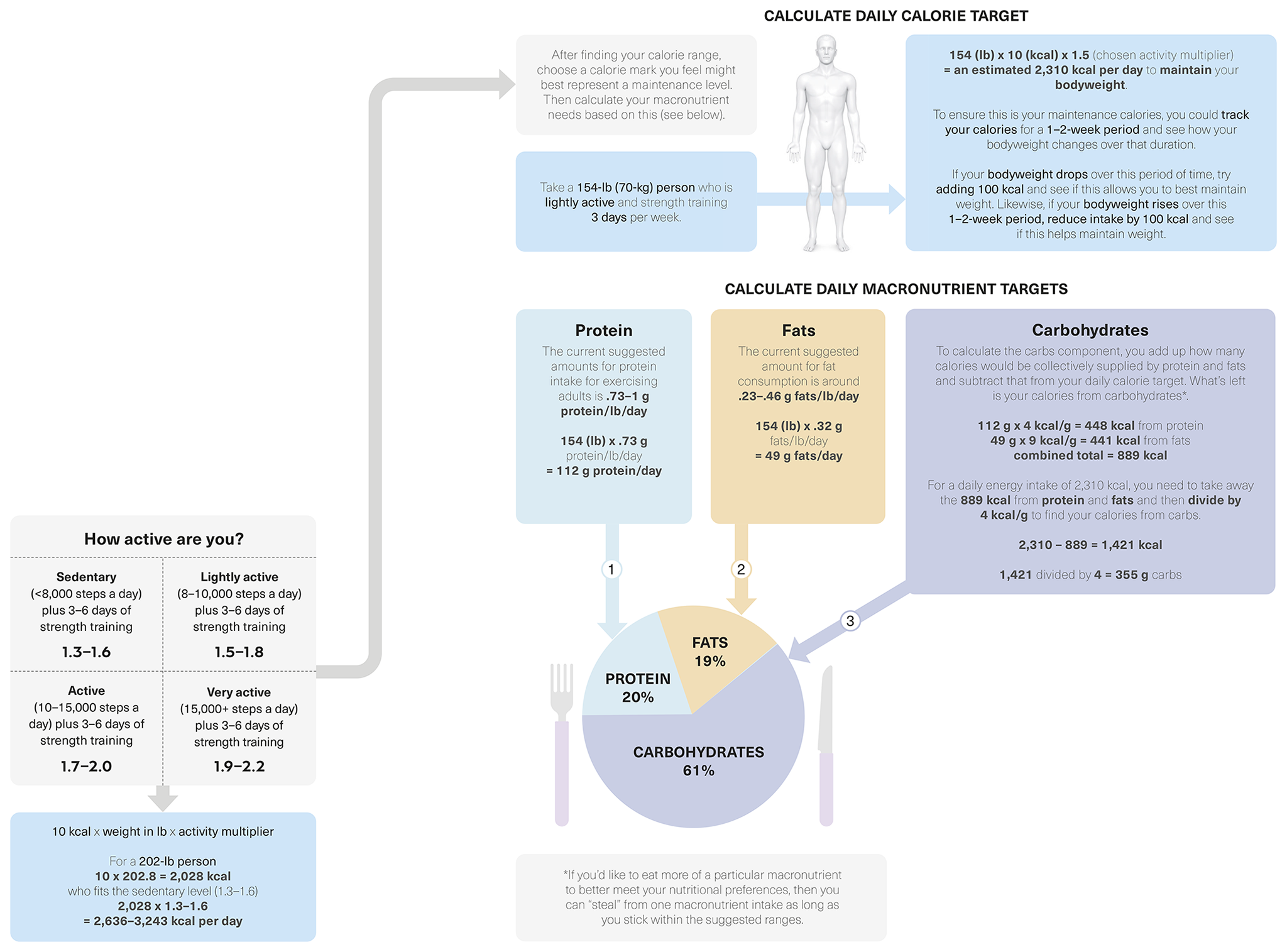Determining your energy requirements
Your total daily energy balance refers to the relationship between the amount of energy you consume (in calories from macronutrients) and the amount that you use for activity. The amount of calories you take in has a direct impact on your ability to gain, lose, or maintain your bodyweight.
Your daily energy balance
Often simplified to “calories in versus calories out,” energy balance is a little more complex than simply thinking about what you consume and the energy you use through exercise. Your body’s total daily energy expenditure covers all kinds of activities, not just exercise (percentages are for an average person). When you consume fewer calories than you expend, you’re in a deficit energy balance; when you consume more calories than you expend, you’re in a surplus energy balance.

n Double-tap image to read the labels
Basal metabolic rate
The amount of energy your body uses at rest to function properly
Exercise activity
The amount of energy used during exercise such as strength training
Non-exercise-related activity thermogenesis
The energy the body uses for tasks such as moving around, cleaning, fidgeting, and cooking
Thermic effect of food
The amount of energy the body uses to digest macronutrients
Your daily calorie intake
In order to best understand how much energy it takes for you to maintain your current bodyweight or body fat levels, you have to do a little bit of math. Determining maintenance calories is typically done by taking your bodyweight and multiplying it by 10 (for weights in lb) or by 22 (for weights in kg). Select the activity level from the chart below that best describes you and use this to work out your daily calorie intake to maintain your bodyweight.

n Double-tap image to read the labels
*If you’d like to eat more of a particular macronutrient to better meet your nutritional preferences, then you can “steal” from one macronutrient intake as long as you stick within the suggested ranges.
How active are you?
| Sedentary (<8,000 steps a day) plus 3–6 days of strength training 1.3–1.6 |
Lightly active (8–10,000 steps a day) plus 3–6 days of strength training 1.5–1.8 |
| Active (10–15,000 steps a day) plus 3–6 days of strength training 1.7–2.0 |
Very active (15,000+ steps a day) plus 3–6 days of strength training 1.9–2.2 |
10 kcal x weight in lb x activity multiplier
For a 202-lb person
10 x 202.8 = 2,028 kcal
who fits the sedentary level (1.3–1.6)
2,028 x 1.3–1.6
= 2,636–3,243 kcal per day
CALCULATE DAILY CALORIE TARGET
After finding your calorie range, choose a calorie mark you feel might best represent a maintenance level. Then calculate your macronutrient needs based on this.
Take a 154-lb (70-kg) person who is lightly active and strength training 3 days per week.
154 (lb) x 10 (kcal) x 1.5 (chosen activity multiplier)
= an estimated 2,310 kcal per day to maintain your bodyweight.
To ensure this is your maintenance calories, you could track your calories for a 1–2-week period and see how your bodyweight changes over that duration.
If your bodyweight drops over this period of time, try
adding 100 kcal and see if this allows you to best maintain weight. Likewise, if your bodyweight rises over this
1–2-week period, reduce intake by 100 kcal and see if this helps maintain weight.
CALCULATE DAILY MACRONUTRIENT TARGETS
Protein
The current suggested amounts for protein intake for exercising adults is .73–1 g protein/lb/day
154 (lb) x .73 g
protein/lb/day
= 112 g protein/day
Fats
The current suggested amount for fat consumption is around
.23–.46 g fats/lb/day
154 (lb) x .32 g
fats/lb/day
= 49 g fats/day
Carbohydrates
To calculate the carbs component, you add up how many calories would be collectively supplied by protein and fats and subtract that from your daily calorie target. What’s left
is your calories from carbohydrates*.
112 g x 4 kcal/g = 448 kcal from protein
49 g x 9 kcal/g = 441 kcal from fats
combined total = 889 kcal
For a daily energy intake of 2,310 kcal, you need to take away the 889 kcal from protein and fats and then divide by 4 kcal/g to find your calories from carbs.
2,310 – 889 = 1,421 kcal
1,421 divided by 4 = 355 g carbs
Start with a calorie deficit—to lose weight
To adjust the figures to cut your calories in a balanced way, you’ll need to first find your maintenance calorie level. Then multiply the calories by 10–15%—a good size deficit—and take that away. This uses a 15% deficit on the above example.
2,310 kcal x 0.15 = ~346.5 kcal
2,310 – 346.5 = 1,963.5 kcal—the new calorie amount
Start with a calorie surplus—to gain weight
To adjust the figures to boost your calories in a balanced way, you’ll need to multiply your maintenance calorie level by 10–15%—a good size surplus—and add that to the daily goal.
This uses a 15% surplus on the above example.
2,310 kcal x 0.15 = ~346.5 kcal
2,310 + 346.5 = 2,656.5 kcal—the new calorie amount
